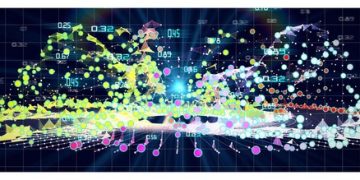AI in Cybersecurity: Balancing Act Between Defense and Threat

Artificial Intelligence (AI) is revolutionizing cybersecurity, offering advanced threat detection and response capabilities, but also creating new avenues for malicious actors to exploit vulnerabilities and enhance cyberattacks.
The integration of Artificial Intelligence (AI) in Cybersecurity: How AI Can Help and Hurt Your Security Posture is rapidly transforming how we approach digital defense, presenting both unprecedented opportunities and significant challenges for security professionals.
The Promise of AI in Cybersecurity
AI offers cybersecurity professionals powerful tools to automate tasks, improve threat detection, and respond more effectively to incidents. By analyzing vast datasets and identifying patterns, AI can detect anomalies and predict potential attacks with greater speed and accuracy than traditional methods.
Enhanced Threat Detection
AI algorithms can sift through massive volumes of network traffic, system logs, and user activities to identify suspicious behavior that may indicate a cyberattack. Machine learning models can learn from historical data to recognize new and evolving threats that might otherwise go unnoticed.
Automated Incident Response
AI can automate many of the tasks involved in incident response, such as isolating infected systems, blocking malicious traffic, and patching vulnerabilities. This can significantly reduce the time it takes to contain and remediate an attack, minimizing the damage caused.
Vulnerability Management
AI can help organizations identify and prioritize vulnerabilities in their systems and applications. By scanning code and configurations, AI can detect potential weaknesses that could be exploited by attackers. It can also assess the risk associated with each vulnerability and recommend appropriate remediation steps.
- AI-powered threat intelligence platforms provide real-time insights into emerging threats and attacker tactics.
- Machine learning algorithms can analyze malware samples to identify their characteristics and develop effective defenses.
- AI can automate security tasks, such as log analysis, vulnerability scanning, and incident response.
In conclusion, AI offers significant advantages in enhancing threat detection, automating incident response, and improving vulnerability management, empowering organizations to proactively defend against cyber threats.

The Dark Side: How AI Can Be Used for Cyberattacks
While AI offers great potential for improving cybersecurity, it also creates new opportunities for malicious actors. AI can be used to automate and enhance cyberattacks, making them more sophisticated and difficult to detect.
AI-Powered Malware
AI can be used to develop malware that can evade traditional detection methods. Machine learning algorithms can be trained to recognize the characteristics of security tools and adapt their behavior to avoid being detected. AI-powered malware can also be designed to self-replicate and spread rapidly through networks.
Social Engineering Attacks
AI can be used to create more convincing and personalized social engineering attacks. Natural language processing (NLP) can be used to generate realistic phishing emails and social media posts that are tailored to individual victims. AI can also be used to create deepfakes that can be used to impersonate trusted individuals.
Automated Vulnerability Exploitation
AI can be used to automate the process of finding and exploiting vulnerabilities. Machine learning algorithms can be trained to scan systems for known vulnerabilities and automatically generate exploits. This can significantly reduce the time it takes for attackers to compromise systems.
The ability to create sophisticated malware that can evade traditional detection methods is aided by AI. These AI-powered malware can self-replicate and spread rapidly within networks.
- AI can be used to generate realistic phishing emails and social media posts that are tailored to individual victims, enhancing social engineering attacks.
- Machine learning algorithms can scan systems for known vulnerabilities and automatically generate exploits, leading to automated vulnerability exploitation.
- AI tools can be used to create deepfakes that impersonate trusted individuals, further complicating the cybersecurity landscape.
In conclusion, while AI presents powerful tools for cybersecurity defense, it also equips malicious actors with capabilities to create sophisticated attacks, demanding continuous vigilance and innovative defense mechanisms.
Defending Against AI-Enabled Attacks
To defend against AI-enabled attacks, organizations need to adopt a multi-layered approach that combines traditional security measures with AI-powered defenses. This includes implementing robust threat detection and response capabilities, as well as investing in AI-specific security tools and training.
AI-Driven Threat Detection
AI-driven threat detection solutions can analyze network traffic, system logs, and user activities to identify suspicious behavior that may indicate an AI-enabled attack. These solutions can learn from historical data to recognize new and evolving attack patterns.
Behavioral Analysis
Behavioral analysis tools can track user and system behavior to identify anomalies that may indicate a compromised account or malicious activity. These tools can use machine learning algorithms to establish baseline behavior and detect deviations from that baseline.
AI-Powered Vulnerability Management
AI-powered vulnerability management solutions can scan systems for known vulnerabilities and prioritize remediation efforts based on the risk associated with each vulnerability. These solutions can also use machine learning algorithms to predict future vulnerabilities.

Implementing AI-driven threat detection solutions allows for the analysis of network traffic and user activities, helping to identify suspicious behavior that may indicate an AI-enabled attack.
In cybersecurity, the use of behavioral analysis tools is essential for tracking user and system behavior to detect any anomalies that may point to compromised accounts or malicious activities. AI-powered vulnerability management solutions help scan systems for known vulnerabilities and prioritize remediation efforts.
- Continuously monitor and analyze network traffic, system logs, and user activities for suspicious behavior.
- Implement behavioral analysis tools to detect anomalies that may indicate a compromised account or malicious activity.
- Use AI-powered vulnerability management solutions to scan systems for known vulnerabilities and prioritize remediation efforts.
In conclusion, defending against AI-enabled attacks requires a proactive and adaptive security posture, leveraging AI-driven tools and strategies to stay ahead of evolving threats.
The Evolving Cybersecurity Landscape
The cybersecurity landscape is constantly evolving, and AI is playing an increasingly important role. As attackers develop new AI-powered attack techniques, defenders must also adapt and adopt new AI-powered defenses.
The Role of Machine Learning
Machine learning is a key component of many AI-powered security solutions. Machine learning algorithms can learn from vast datasets to identify patterns and predict future events. This makes them well-suited for tasks such as threat detection, vulnerability management, and incident response.
The Importance of Data
Data is essential for training and evaluating machine learning models. Organizations need to collect and analyze data from a variety of sources to build effective AI-powered security solutions. This includes network traffic data, system logs, user activity data, and threat intelligence data.
The Need for Collaboration
Collaboration between security professionals, data scientists, and AI experts is essential for developing and deploying effective AI-powered security solutions. This includes sharing data, threat intelligence, and best practices.
Collaboration between security professionals, data scientists, and AI experts is essential for developing and deploying effective AI-powered security solutions, including sharing data, threat intelligence, and best practices.
Machine learning algorithms can learn from vast datasets to identify patterns and predict future events, making them well-suited for tasks such as threat detection, vulnerability management, and incident response.
- Continue to invest in research and development of new AI-powered security solutions.
- Promote collaboration between security professionals, data scientists, and AI experts.
- Establish industry standards and best practices for the use of AI in cybersecurity.
In conclusion, the evolving cybersecurity landscape demands continuous learning, adaptation, and collaboration to effectively leverage AI for defense and mitigate its potential risks.
Ethical Considerations of AI in Cybersecurity
As AI becomes more prevalent in cybersecurity, it is important to consider the ethical implications of its use. AI-powered security solutions can raise concerns about privacy, bias, and accountability.
Data Privacy
AI-powered security solutions often require access to vast amounts of data, including personal information. Organizations need to ensure that they are collecting and using this data in a responsible and ethical manner. This includes obtaining consent from individuals before collecting their data, as well as implementing measures to protect their privacy.
Bias
AI-powered security solutions can be biased if they are trained on biased data. This can lead to unfair or discriminatory outcomes. Organizations need to carefully evaluate their data to ensure that it is representative and unbiased.
Accountability
It can be difficult to hold AI systems accountable for their actions. Organizations need to establish clear lines of responsibility for the decisions made by AI-powered security solutions. This includes developing policies and procedures for addressing errors and biases.
Organizations need to carefully evaluate their data to ensure that it is representative and unbiased to avoid unfair or discriminatory out-comes with AI-powered solutions.
Establishing clear lines of responsibility for the decisions made by AI-powered security solutions, including developing policies and procedures for addressing errors and biases, is essential.
- Develop ethical guidelines for the use of AI in cybersecurity.
- Ensure that AI-powered security solutions are transparent and explainable.
- Establish clear lines of responsibility for the decisions made by AI systems.
In conclusion, considering the ethical implications is essential to ensure that AI is used responsibly and ethically in cybersecurity, protecting both individuals and organizations.
The Future of AI in Cybersecurity
The future of AI in cybersecurity is bright. As AI technology continues to evolve, it will play an increasingly important role in protecting organizations from cyber threats.
The Rise of Autonomous Security Systems
Autonomous security systems are AI-powered systems that can automatically detect and respond to cyber threats without human intervention. These systems can learn from experience and adapt to new and evolving threats.
AI-Powered Threat Hunting
AI-powered threat hunting solutions can proactively search for hidden threats that may have evaded traditional security measures. These solutions can use machine learning algorithms to identify suspicious patterns and anomalies that may indicate a stealthy attack.
The Convergence of AI and Cybersecurity
The convergence of AI and cybersecurity will lead to the development of new and innovative security solutions that can address the challenges of a rapidly evolving threat landscape. This includes solutions that can automatically adapt to new threats, personalize security defenses, and provide real-time threat intelligence.
Autonomous security systems can learn from experience and adapt to new and evolving threats, enabling them to manage many cyberthreats without needing assistance.
The convergence of AI and cybersecurity will lead to the development of new and innovative security solutions that can address the challenges of a rapidly evolving threat landscape.
- Develop autonomous security systems that can automatically detect and respond to cyber threats.
- Use AI-powered threat hunting solutions to proactively search for hidden threats.
- Promote the convergence of AI and cybersecurity to develop new and innovative security solutions.
In conclusion, the future of AI in cybersecurity holds immense potential for transforming digital defenses, but requires ongoing research, development, and collaboration to harness its full capabilities.
| Key Point | Brief Description |
|---|---|
| 🛡️ AI for Threat Detection | AI enhances anomaly detection and predicts potential attacks. |
| 🤖 AI-Powered Attacks | AI can create sophisticated malware and social engineering attacks. |
| 👨💻 Defending AI Threats | Utilize AI for threat detection, behavioral analysis, and vulnerability management. |
| 🔑 Ethical AI | Address concerns about data privacy, bias, and accountability in AI use. |
Frequently Asked Questions (FAQ)
▼
AI enhances threat detection by analyzing vast datasets to identify patterns and anomalies that may indicate a cyberattack, enabling quicker and more accurate threat identification.
▼
The risks include potential biases in algorithms, increased privacy concerns due to data collection, and the ethical implications of autonomous decision-making in security systems.
▼
AI can power sophisticated malware, automate vulnerability exploitation, and enhance social engineering attacks, making them more personalized and difficult to detect.
▼
Organizations should adopt AI-driven threat detection, behavioral analysis, and AI-powered vulnerability management solutions to proactively defend against evolving AI-enabled threats.
▼
Ethical considerations are vital to ensure that AI is used responsibly, addressing issues like data privacy, minimizing bias, and establishing accountability for the AI systems actions and decisions.
Conclusion
In the ongoing cybersecurity landscape, AI presents a dual-edged sword. While it offers tools for enhanced threat detection and automated response, it also introduces new risks through its potential misuse. Organizations must adopt a balanced approach, combining AI-powered defenses with traditional security measures and ethical considerations to navigate effectively and securely in this evolving digital environment.





